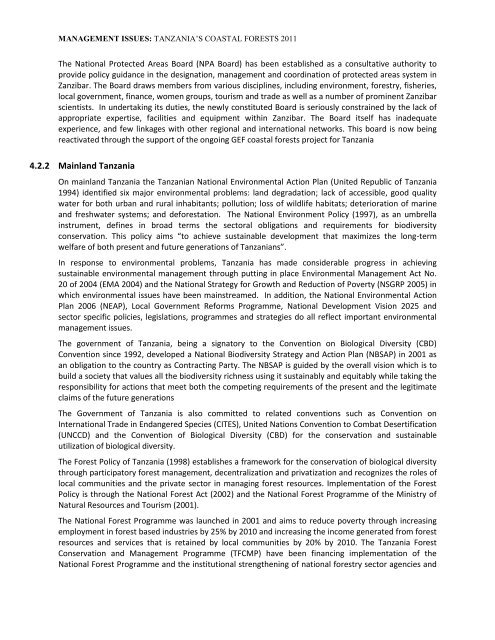Neil D. Burgess, Paul Harrison, Peter Sumbi, James Laizer, Adam ...
Neil D. Burgess, Paul Harrison, Peter Sumbi, James Laizer, Adam ...
Neil D. Burgess, Paul Harrison, Peter Sumbi, James Laizer, Adam ...
Create successful ePaper yourself
Turn your PDF publications into a flip-book with our unique Google optimized e-Paper software.
MANAGEMENT ISSUES: TANZANIA’S COASTAL FORESTS 2011<br />
The National Protected Areas Board (NPA Board) has been established as a consultative authority to<br />
provide policy guidance in the designation, management and coordination of protected areas system in<br />
Zanzibar. The Board draws members from various disciplines, including environment, forestry, fisheries,<br />
local government, finance, women groups, tourism and trade as well as a number of prominent Zanzibar<br />
scientists. In undertaking its duties, the newly constituted Board is seriously constrained by the lack of<br />
appropriate expertise, facilities and equipment within Zanzibar. The Board itself has inadequate<br />
experience, and few linkages with other regional and international networks. This board is now being<br />
reactivated through the support of the ongoing GEF coastal forests project for Tanzania<br />
4.2.2 Mainland Tanzania<br />
On mainland Tanzania the Tanzanian National Environmental Action Plan (United Republic of Tanzania<br />
1994) identified six major environmental problems: land degradation; lack of accessible, good quality<br />
water for both urban and rural inhabitants; pollution; loss of wildlife habitats; deterioration of marine<br />
and freshwater systems; and deforestation. The National Environment Policy (1997), as an umbrella<br />
instrument, defines in broad terms the sectoral obligations and requirements for biodiversity<br />
conservation. This policy aims “to achieve sustainable development that maximizes the long-term<br />
welfare of both present and future generations of Tanzanians”.<br />
In response to environmental problems, Tanzania has made considerable progress in achieving<br />
sustainable environmental management through putting in place Environmental Management Act No.<br />
20 of 2004 (EMA 2004) and the National Strategy for Growth and Reduction of Poverty (NSGRP 2005) in<br />
which environmental issues have been mainstreamed. In addition, the National Environmental Action<br />
Plan 2006 (NEAP), Local Government Reforms Programme, National Development Vision 2025 and<br />
sector specific policies, legislations, programmes and strategies do all reflect important environmental<br />
management issues.<br />
The government of Tanzania, being a signatory to the Convention on Biological Diversity (CBD)<br />
Convention since 1992, developed a National Biodiversity Strategy and Action Plan (NBSAP) in 2001 as<br />
an obligation to the country as Contracting Party. The NBSAP is guided by the overall vision which is to<br />
build a society that values all the biodiversity richness using it sustainably and equitably while taking the<br />
responsibility for actions that meet both the competing requirements of the present and the legitimate<br />
claims of the future generations<br />
The Government of Tanzania is also committed to related conventions such as Convention on<br />
International Trade in Endangered Species (CITES), United Nations Convention to Combat Desertification<br />
(UNCCD) and the Convention of Biological Diversity (CBD) for the conservation and sustainable<br />
utilization of biological diversity.<br />
The Forest Policy of Tanzania (1998) establishes a framework for the conservation of biological diversity<br />
through participatory forest management, decentralization and privatization and recognizes the roles of<br />
local communities and the private sector in managing forest resources. Implementation of the Forest<br />
Policy is through the National Forest Act (2002) and the National Forest Programme of the Ministry of<br />
Natural Resources and Tourism (2001).<br />
The National Forest Programme was launched in 2001 and aims to reduce poverty through increasing<br />
employment in forest based industries by 25% by 2010 and increasing the income generated from forest<br />
resources and services that is retained by local communities by 20% by 2010. The Tanzania Forest<br />
Conservation and Management Programme (TFCMP) have been financing implementation of the<br />
National Forest Programme and the institutional strengthening of national forestry sector agencies and

















